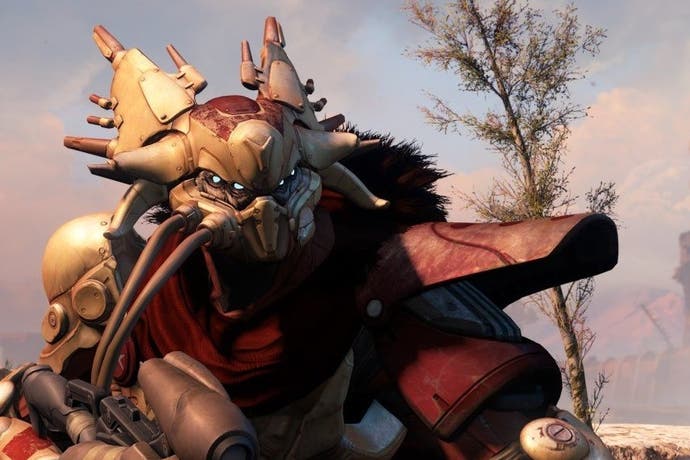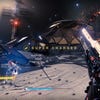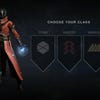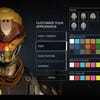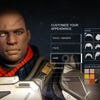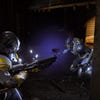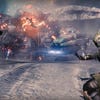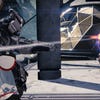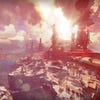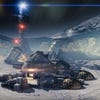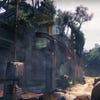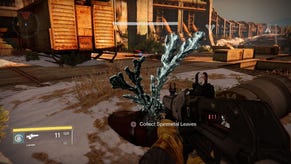Bleeding red and blue: Destiny's competitive multiplayer cut wide open
Bungie peels back another layer, and the feeling within is familiar.
Destiny's competitive multiplayer is all about ammo.
Well, it's not all about ammo. A lot of it is about sprinting, shooting and double-jumping, but ammo plays an important role. In fact, Destiny's ammo is the key to victory.
The thing I loved about Halo's player-versus-player shooting was that everyone started the game on a level playing field. Sure, you'd fight over the powerful weapons as they spawned, the rocket launcher, the shotgun, the sniper rifle, that sort of thing, but at the start of each round everyone had to row up the creek using the same splintered paddle. There was none of this levelling up and unlocking weapons and boosts and all that other modern guff that turns me off the likes of Battlefield, Call of Duty and, admittedly, Halo in recent years. Classic Halo chucked us into a virtual goldfish bowl with evenly matched starting loadouts and let players fight for control over the map. It was balanced.
Destiny is a little different. By design every Guardian is at a different stage of progression. You might have an auto rifle of doom, a nightmarish shotgun and a rocket launcher worthy of kings because you've spent hours exploring the world, defeating Strikes and playing the campaign, and scored sweet loot in the process. Destiny's Guardians, your Guardians, are persistent across all modes: single-player, co-op and competitive. You kill other Guardians with your own unique weapons and block damage and boost your stats with your own unique armour, whatever it might be.
So, when you start a round of six-versus-six Control on the Rusted Lands map, set in the Eastern Flood Zone on Earth, whether you're on alpha team or bravo team, whether you're red or blue, you're not fighting on a level playing field. You have no idea which kind of stat boost that level-eight Warlock on the other team is getting from his snazzy chest piece, or whether that Hunter is packing a shotgun or a sniper rifle in her special weapon slot. And they have no idea what you've got up your sleeve, either.
Bungie can't level Destiny's playing field, but it can squish it down into a lumpy pulp. And it's done exactly that by tweaking the way ammo works.
Your Guardian can have up to three weapons on the go at any one time, one of each weapon type: a primary weapon, a special weapon and a heavy weapon. Well, you might not even have that many, depending on how your adventures out in the wilderness have gone (I didn't score a heavy weapon until level seven). But let's assume you've got one of each. I had an auto rifle in my primary slot, a sniper rifle in my special slot and a machine gun in my heavy slot.
Each weapon type uses a corresponding type of ammo. Primary weapons use common ammo, which is dropped by enemy players when you kill them. You start each round with plenty of that good stuff. Special weapons use special ammo, coloured green in the game world. This is rarer, and is looted from caches dotted around the map. You start each round with a limited amount of special ammo, but there's plenty to go around so you're never normally short.
But you start a round of Destiny's competitive multiplayer with no heavy ammo. You've got your heavy weapon equipped, but you can't use it. You have to wait for the game to drop heavy ammo onto the battlefield, but it only does so a few times a round.
The commentator, a softly spoken Englishman who sounds like he could do with a pick me up, lets everyone know when heavy weapon ammo is on its way. Then, when it drops, he lets everyone know it's dropped. It's at this point you can feel the heads turn - you scan the battlefield for that little purple pop-up that indicates where and how far away the ammo is and you think, should I stop what I'm doing and go for it? Of course I should. You click in the thumb stick and sprint as fast as your Guardian's legs will carry you, and if you're lucky enough to get there first, you're cooking.
Destiny's heavy weapons are devastating. My machine gun mows down enemy Guardians as if it's a turret. My other heavy weapon is a rocket launcher, and, like the rocket launcher in Halo, it's a one-hit-kill affair - jump, maybe double-jump, and let rip from above. You don't have to hit your target, of course. The splash damage should be enough to do the trick.
This spawning ammo system means when you get heavy weapon ammo you feel supercharged. It's as though you've got the invincibility star in Mario. You throw caution to the wind and seek out enemies, no matter what the situation (you probably shouldn't play this way but, hey ho, it's fun). Watch the motion tracker for flashes of red, spin, sprint and spray. But, when the ammo is gone, it's gone. And you don't get a lot of it. Go nuts, but not indefinitely.
It lends an old-school FPS beat to the rhythm of play. You wait for the commentator to sound the bell then, hopefully, nab the heavy ammo. If you don't get it, you know someone else has it. If they're on your team, great. If they're not, best tread carefully.
It's like Halo, when you think about it. I spent many an hour trying to nab the rocket launcher in Foundation so I could cause pretty mayhem with it until I ran out of rockets. Destiny works the same way, except you need to activate whatever heavy weapon you're using with the ammo rather than find the heavy weapon in the first place. It's a smart workaround to the levelling the playing field problem Destiny's persistent character progression creates.
"It's like Halo." When I visited Bungie in April to play a co-op Strike for the first time, I reported Destiny played like Halo. Well, of course it did. This is a Bungie first-person shooter after all. Now I've played the competitive multiplayer portion of the game - for many Bungie fans the whole point - I'm reporting the same thing. Shooting up Guardians as a Guardians feels like shooting up Spartans as a Spartan. Muscle memory from years spent playing Bungie's Halo games takes over.
But there are important differences. Destiny's competitive multiplayer plays a lot faster than Halo. Guardians have Master Chief's floaty jump and shield and stamina health system, but they sprint much faster than Spartans. And then there's the double-jump, which lets you easily get up onto rooftops, enclosed control points and into great sniping positions. The weighty, satisfying gunplay leans towards ADS (aiming down sights), rather than shooting from the hip. And talking of the gunplay, Destiny's weapons are lethal. Even primary weapons, such as the auto rifle, take out Guardians in what feels like a blink of an eye, so you need to have your wits about you at all times. If a Guardian catches you napping it's usually game over. Unlike in Halo, where it's possible in many situations to absorb some damage and get away, in Destiny there is no escape. Combat resolves itself very quickly. You enter combat, kill or be killed, respawn then go again. It's fast, frenetic and, dare I say it, a little Call of Duty.
The Rusted Lands map is clearly designed with double-jumping in mind. In one section the rubble has been arranged to form a quite obvious ramp that, if you run and jump off of it then double-jump, will send you flying neatly through a hole into the top floor of the building opposite. In Control, your team fights the other team over three points, A, B and C. Stand in one of the control zones and you start to neutralise it. Neutralise it and you score points for your team. Stick around and you start to capture it. Capture it and you score points for your team. And then it's on to the next capture point, whichever one is being neutralised by the other team, probably. The thing is, because of how fast you can move and the double-jump, you can get across the map to other capture points quickly. You're always on the move. It's breathless fun. The 10-minute round timer feels more like five.
This has a lot to do with the map, The Rusted Lands, which caters for a maximum of 12 players. It's dense, with streets packed with rubble, broken pipes and puddles. There are nooks and crannies for close-quarters combat and burnt out buildings in which control points are relentless killing grounds. As with most shooters with a Control game type, in Destiny lobbing a grenade towards the flag before entering the fray is a good idea.
I was worried Rusted Lands was all the Destiny alpha had to offer on the competitive multiplayer side, but I discovered another, called First Light, set in the Mare Cognitum area of the Moon. It only turned up once in the rotation, so I don't have as good a handle on it as I do with Rusted Lands, but I did get enough of a taste to happily report that Destiny's PVP includes one of my favourite things about Halo's PVP: big maps and vehicles.
First Light is a large enough map that you can summon your Sparrow to get around quicker, as you can in the PVE portion of the game. There are a couple of bases, a few turrets, plenty of Pikes and the odd Interceptor.
The turrets push the camera back a bit, as they do in Halo, and sit your Guardian behind a protective shield. They pump out powerful rounds that decimate any Guardian foolish enough to stumble into their sights.
Then there's the Pike. which is like your Sparrow except it has a couple of powerful guns on the front that spew some kind of sci-fi plasma. I had a good time on the Sparrow, hovering around, waiting for Guardians to appear then bringing them down. I even managed to capture a control point while on one of them.
And then there's the chunky and compact Interceptor tank. It moves slowly, but fires a big cannon, which is just what you need for dealing with Guardians, Guardians on Pikes and, well, Guardians in other Interceptors.
It was on the Moon that Destiny felt more like Halo than ever. Perhaps this was because the double jump had less of an impact, or maybe it was because despite your speed it still took a while to get into the action, But really it was because I was flying about on Destiny's version of Halo's Ghost, dropping enemy shields here there and everywhere.
I find Destiny's competitive multiplayer wholesome and reassuring, with notable twists on the Halo experience. But I expect there will be some who ask, where's the innovation? I remember when Respawn's Titanfall burst onto the scene. It was so exciting because it looked like it would move the FPS genre forward. The Pilots with their every which way movement and mobility, versus the Titans, these powerful mechs that could dominate a map all on their own. Titanfall was so interesting because, at least on the face of it, it was so refreshing. And in the age of ballooning triple-A budgets and risk averse publishers, refreshing is hard to come by. Destiny's PVP doesn't spark the same reaction - yet.
I could point to the fact that everything you do in PVP feeds into your persistent character progression. PVP takes place in The Crucible, which is its own faction back at The Tower, where Crucible vendors, such as Crucible Handler Lord Shaxx, sell weapons and armour you can only get if you have a high enough Crucible level and enough Crucible Marks. You have a level of reputation with The Crucible, too, as you do with the Vanguard and the other factions in the game, although I'm not sure how reputation is used just yet. And there are Crucible-specific bounties, such as 'defeat 25 Titans', and 'defeat 20 Guardians with your melee attack', that carry their own set of rewards.
So, you play PVP, earn Crucible Marks then, when you're done, head back to The Tower and see what you can get. In the alpha there's not much going you can use (the level cap is set at eight). But you can see higher level gear, legendary level 20 Crucible chest pieces, gauntlets and all the rest. They're enticing. They spark you into playing more.
And that's exactly what I want to do with Destiny - play more. Even at this early alpha stage, and with most of Destiny's PVP still hidden from view, I'm having loads of breezy, fast-paced and familiar fun. Control is just one of the game types in The Crucible menu screen. I counted five others. I look forward to finding out what they are.
